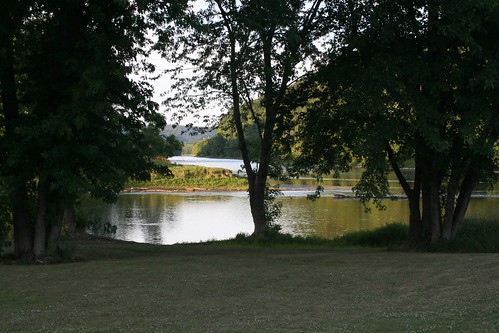(News-Herald, July 24)I’m barely old enough to remember when the Latonia Theater was a real, live operating theater (at least that’s my story, and I’m sticking to it). But I’m old enough to appreciate the place today.
I missed the Oil Heritage tour, but I took a trip over Tuesday night and got the super-deluxe tour of this work-in-progress.
The Latonia went into operation in 1929, just in time for the death of silent cinema and the stock market crash. It operated for many years as a Warner theater and was, in its prime, a great piece of art deco architecture.
Like many local theaters, it didn’t make it to the 1970’s. The problem with theaters is that they’re really cool spaces that aren’t good for much of anything else. So when they’re bought, they suffer through a great deal of renovating, and sometimes the original charm is hopelessly lost.
The Latonia certainly suffered from its transition to business space. Most famously, a concrete floor was inserted halfway between the original floor and ceiling, and shops and offices were shoehorned into the bottom half.
But what is left is exceptional. Walk up the sweeping staircase and you are looking at a circular mezzanine balcony above the lobby, ringed by a railing that represents some of the last iron-work that Wendell August Forge ever created. Across from that rail is an art deco fountain; facing it from the other corner is a fireplace. Both are in fine shape. Past the fireplace is the original office for the theater, with a conveniently located window that allowed the boss to look down over the house.
That’s all pretty cool, but the revelation is on the other side of the rail. Pass through a door and you are looking across that giant concrete slab, obviously out of place.
Originally you would have been entering here at balcony level, and the upper balcony is behind you, stretching up a reeeeeeeeally long way eventually to the projection room (located so far from everything else in the building that it has its own little rest room.
Opposite the balcony is the top of the stage, eight or nine feet of proscenium sticking up above the slab (the rest of the stage is intact, a few artificial floors down). The whole room gives a bit of the impression of something from a disaster movie, a building that has been engulfed and filled by snow or lava.
What dominates this large room is the biggest art deco chandelier I have ever seen in my life. Weighing more than a couple of tons, operating on three separate circuits, and requiring half a billion light bulbs (maybe closer to 800—but, dang!), it hangs below a sweeping dome which is itself resting on the wings of a circle of golden eagles. It’s impossible to look at it and not think, “Wow! I need a picture of that.”
The room ends up looking more like a ballroom or Greco-Roman amphitheater than a conventional theater, though it would be a great place to play a small show in the round. The acoustics are striking, but in 1929 the best sound system a theater could have still only put out about 50 watts, so the acoustics in a big room still had to be good. This certainly sounds like it has a large bare concrete floor, but with some carpet to take the edge off, it will be a unique space.
The stage is pretty shallow with virtually no space in the wings, but then, performers could walk out of the wings into a labyrinth of dressing rooms, storage rooms, and even showers. Doors lead to doors and the backstage area is further honeycombed with ladders and staircases and trap doors. A group of twelve-year-old boys could be entertained for a week.
The owners, Linda Henderson and Roxanne Hitchcock, have ideas and plans and a grant, God bless them, and they‘re to be commended for taking on this monstrous project.
The timing is in many ways perfect; this is a facility that can pick up some of the slack created by the Franklin Club’s self-destruction. And while purists may bemoan the presence of other businesses in the building, a steady source of income for this kind of operation is a major bonus.
And I know some people just can’t help themselves—if someone in Franklin or Oil City sneezes, they have to look for someone in the other town to sneeze bigger or louder or snottier—but the Latonia isn’t competition for the Barrow. They’re two types of operations, offering different settings and services.
Right now, the Latonia is trying a Tuesday night jam session starting at 6:30. Come listen, or come gawk, or do both. You can contact the Latonia folks at 677-1260 or e-mail thelatonia@verizon.net.











